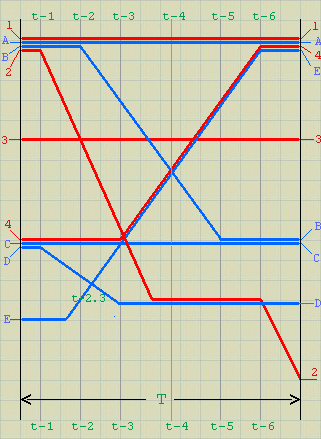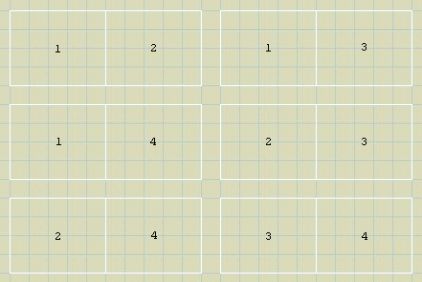|
|
Traditional film narration is based, generally speaking, on joining together bigger or smaller fragments of recorded events into one time flow based
on linear sequence.
A film recorded in such a manner can be graphically presented as
a combination of lines, varying in length, in which the distances between those lines stand for all montage figures, whereas the overall length stands for the length of the actual
screening.

A contrary approach considers film as pure, unmodified recording.
An analogous graphic representation is nothing but a continuous line limited by two points: the beginning and the end of the
screening.

Let's take yet another possible approach.

A film camera, either static or moving, recording without any breaks
is an OBSERVER.
- I limit the number of OBSERVERS to four.
(their number may be infinite)
- I limit the number of CHARACTERS to five.
(their number may be infinite)
- I limit the recording TIME to T.
(the recording time may be infinite)
- I propose to divide the screen into two parts
(the number of parts may be infinite)
An analogous graphic representation of such a film may look as follows:
- - > it does not represent the movement of the CHARACTERS and OBSERVERS, although it implies some motion. For example:
CHARACTERS A and B, together since the very beginning of T, at t-2 go their own ways. At t-5 B meets C and they stay together till the
very end of T. A, on the other hand, at t-6 meets E which at t-2 had a short encounter with D, at t-3 with C, and at t-4 with B. D, after its encounter with E, at t-2.3 stays alone till the very end of T. The lines, as I have already said, do not represent movement but passing of time and the encounters.
It was indeed possible for E to travel and pass by D,C,B and A. But it could have just as well been D,C,B and A which travelled and passed by the motionless E.
Crossing of the OBSERVER's line with the line of the CHARACTER or their nearing one another means that the CHARACTER enters the OBSERVER'S field of vision. Thus, OBSERVER 1 watches CHARACTER A throughout the entire T, then CHARACTER B in t-0/t-1, and also CHARACTER E in t-6/t-n. OBSERVER 2 watches in t-0/t-1 the same situation as OBSERVER 1. Because 2 cannot be 1, the point of observation is different.
In t-2 there is no CHARACTER within the field of vision of OBSERVER 2, but the view being recorded is directly linked in space with the view being recorded by OBSERVER 3. In t-3 OBSERVERS 2 and 4 watch the same situation, that is, a short encounter of CHARACTER C with CHARACTER E. In t-3.4/t-6 OBSERVER 2 watches CHARACTER D and then in t-6 changes its point of interest. Etc...

The nature of time and space interdependence: CHARACTER-CHARACTER, CHARACTER-OBSERVER, OBSERVER-OBSERVER manifests itself during the actual screening.
All the happenings recorded by the OBSERVERS are being synchronously projected onto the two-part screen in order to compare the recordings. T repeats itself six times.
Assuming the number of parts the screen may be divided into is infinite
(or in this particular case totals at least four), time T does not have to repeat itself.
Should we accept the above-presented assumptions, each and every attempt at reaching their limits automatically reduces easy perception
to its minimum.
Let's stay, therefore, with the simple approach, bearing in mind that it refers to an unknowable situation. Let's treat it as just one of several
possibilities.
published in:
WARSZTAT- first issue, 1974
ROZMOWY- published by the author, 1974
| |



The text entered the best-script competition organized by Łódź Film School in 1973.
It later appeared in the WARSZTAT's publications.
I have the impression that it served as inspiration (but not necessarily so) for Zbyszek Rybczyński.
Anyway, a few years later I saw my idea made into a film under the title of 'New Book' (Nowa Książka). Zbyszek Rybczyński's film resembled the idea I had elaborated on in my text but it was not really the same thing. 'New Book' was filmed with one camera and despite rigorous discipline on the set, TIME towards the end had to be either accelerated or slowed down in order for all the happenings to appear synchronous.
My idea was to use many cameras which would be turned on all at the same time.
|